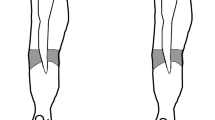Summary
On the basis of behavioural studies the influences that coordinate the movement of the legs of a slowly walking cat have been investigated. The recording method applied here allows for the measurement of forward and backward movement of the legs which are called swing and stance movements, respectively. Influences etween contralateral legs, i.e. both front legs or both hind legs, are stronger than those occurring between ipsilateral legs, i.e. front and hind leg of the same side. Influences which coordinate the front legs seem to be of the same kind as those for the hind legs. These influences are symmetrical, which means that the same type of influence acts from right to left leg and in the reverse direction. Two types of influences are described for contralateral legs: 1. When the influencing leg performs a swing movement, the influenced leg is prevented from starting a swing movement. 2. When the influencing leg performs a stance movement, the probability that the influenced leg starts a swing movement increases as the influencing leg moves backwards during its stance movement. In contrast to contralateral coupling, the ipsilateral influences are asymmetric, i.e. a different influence acts from front to hind leg than does in the reverse direction. The front leg is influenced to start a swing when both legs have approached each other to a given value. The hind leg is influenced to start a stance movement after the front leg has begun its swing.
Similar content being viewed by others
References
Batschelet E (1983) Circular statistics in biology. Academic Press, London, New York
Carter MC, Smith JL (1986) Simultaneous control of two rhythmical behaviors. I. Locomotion with paw-shake response in normal cat. J Neurophysiol 56:171–183
Cruse H (1990) What mechanisms coordinate leg movement in walking arthropods? Trends Neurosci 13:15–21
Cruse H, Müller U (1986) Two coupling mechanisms which determine the coordination of ipsilateral legs in the walking crayfish. J Exp Biol 121:349–369
Cruse H, Knauth A (1989) Coupling mechanisms between the contralateral legs of a walking insect (Carausius morosus). J Exp Biol 114:199–213
Cruse H, Schwarze W (1988) Mechanisms of coupling between the ipsilateral legs of a walking insect (Carausius morosus). J Exp Biol 138:455–469
English AW (1979) Interlimb coordination during stepping in the cat: an electromyographic analysis. J Neurophysiol 42:229–243
Godden DH, Graham D (1983) Instant analysis of movement. J Exp Biol 107:505–508
Grillner S (1981) Control of locomotion in bipeds, tetrapods, and fish. In: II, Papenheimer JR, Forster RE, Mammaerts W, Bullock TH (eds) Handbook of physiology the nervous system American Physiological Society, Washington DC, pp 1179–1236
Halbertsma J (1983) The stride cycle of the cat: the modelling of locomotion by computerized analysis of automatic recordings. Acta Physiol Scand (Suppl) 521:1–75
Kato M, Murakami S, Yasuda K, Hirayama H (1984) Disruption of fore and hindlimb coordination during overground locomotion in cats with bilateral serial hemisection of the spinal cord. Neurosci Res 2:27–47
Lloyd DPC, McIntyre AK (1984) Analysis of forelimb-hindlimb reflex activity in acutely decapitate cats. J Neurophysiol 11:455–470
Lennard PR (1985) Afferent perturbations during “monopodal” swimming movements in the turtle. Phase dependent curtaneous modulation and proprioceptive resetting of the locomotor rhythm. J Neurosci 5:1434–1445
Miller S, Reitsma DJ, Meche FGA van der (1973) Functional organization of long ascending propriospinal pathways linking lumbo-sacral and cervical segments in the cat. Brain Res 62:169–188
Miller S, Schomburg ED (1985) Locomotor coordination in the cat. In: Bush BMH, Clarac F (eds) Coordination and behavior. Cambridge University Press, Cambridge, pp 201–220
Miller S, Burg J van der, Meche FGA van der (1975a) Coordination of movements of the hindlimbs and forelimbs in different forms of locomotion in normal and decerebrate cats. Brain Res 91:217–237
Miller S, Burg J van der, Meche FGA van der (1975b) Locomotion in the cat: basic programmes of movement. Brain Res 91:239–253
Miller S, Meche FGA van der (1975) Movements of the forelimbs of the cat during stepping on a treadmill. Brain Res 91:255–269
Müller U, Cruse H (1991) The contralateral coordination of walking legs in the crayfish, Astacus leptodactylus. II. Model calculations. Biol Cybern 64:437–446
Pavlidis T (1973) Biological oscillators: their mathematical analysis. Academic Press, New York, London
Schomburg ED, Meinck HM, Haustein J, Roesler J (1978) Functional organization of the spinal reflex pathways from forelimb afferents to hindlimb motoneurones in the cat. Brain Res 139:21–33
Schomburg ED, Steffens H, Warneke G (1986) Functional organization of the spinal reflex pathways from forelimb afferents to hindlimb motoneurones in the cat. II. Conditions of the interneuronal connections. Brain Res 375:280–290
Shik ML, Orlovskii GN (1965) Co-ordination of the limbs during running of the dog. Biofizika 10:1037–1047
Shimamura M, Fuwa T, Kogure I (1985) Burst discharges of pontine reticular neurons in relation to forelimb stepping of thalamic and high spinal cats. Brain Res 346:363–367
Stein PSG (1976) Mechanisms of interlimb control. In: Hermann RM, Grillner S, Stein PSG, Stuart DG, (eds) Neural control of locomotion Plenum Press, New York, pp 465–487
Wetzel MC, Stuart DG (1976) Ensemble characteristics of cat locomotion and its neural control. Prog Neurobiol 7:1–98
Author information
Authors and Affiliations
Rights and permissions
About this article
Cite this article
Cruse, H., Warnecke, H. Coordination of the legs of a slow-walking cat. Exp Brain Res 89, 147–156 (1992). https://doi.org/10.1007/BF00229012
Received:
Accepted:
Issue Date:
DOI: https://doi.org/10.1007/BF00229012




